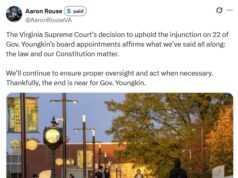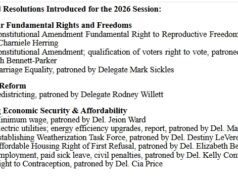 the assembled delegates adopted the final version of a document which began like this:
the assembled delegates adopted the final version of a document which began like this:
We the People of the United States, in Order to form a more perfect Union, establish Justice, insure domestic Tranquility, provide for the common defence, promote the general Welfare, and secure the Blessings of Liberty to ourselves and our Posterity, do ordain and establish this Constitution for the United States of America.
It is interesting to remember that the document which came out of the Committee on Style, chaired by Roger Sherman, had somehow left out one thing it had received, for no apparent reason. Originally offered by Charles Pinckney of SC, it was moved from the floor and unanimously adopted by the convention, the last part of the Constitution, and critically important, found at the end of Article VI:
but no religious Test shall ever be required as a Qualification to any Office or public Trust under the United States.
Please continue reading.
Today is Constitution Day. Under Federal legislation offered by the late Sen. Robert Byrd of WV, every public school is supposed to do a lesson on this document sometime during the week of this anniversary. Since I am already teaching about the Constitution in all of my classes, regular and Advanced placement, I will take a moment to remind my students of the occasion, then move on.
Most Americans will, unfortunately, not even take such a moment.
We should.
It was far from a perfect document.
It lacked the protections of a Bill of Rights, which was why George Mason, author of Virginia’s Declaration of Rights in 1776, refused to sign it. Given the additional opposition of Patrick Henry, Virginia would not have ratified without the commitment to add one.
It allowed for changes, through the Amendment process of Article V. Not only would 12 Amendments be proposed in the 1st Congress meeting in 1789, of which 11 would eventually be adopted – the ten known as the Bill of Rights and almost two centuries later the one now number 27 – but several others, the 11th and 12th, to address problems encountered in the first few decades of the new nation.
It has certain fundamental principles, some – separation of powers, checks and balances – not original inventions of the convention, but one – a government structured on a federal basis – so knew that it took us at least until 1865 and a war between regions to set some limitations on what the state power portion of that federal basis was to mean.
It set some clear constitutional limits – neither states nor the national government could grant titles of nobility – that are emblematic of our being a republic – res publica, which was part of the answer Dr. Franklin gave when asked after the Convention rose from its self-imposed secret meetings what kind of government it had given the people: “A Repulic, if you can keep it.”
Its provisions have not always been strictly followed: both our 16th and 43rd presidents sought to ignore one of the most important restrictions on governmental power, found in Article 1 Section 9, The Privilege of the Writ of Habeas Corpus shall not be suspended, unless when in Cases of Rebellion or Invasion the public Safety may require it. Lincoln submitted his action to the approval of the Congress, and there was a rebellion. It seems harder to justify the actions of the last administration.
I am particularly appreciative of the last part added, in part because of my Jewish heritage and my current self-identification as a Quaker. As the latter, I also note that oaths are not required, but instead affirmations can be offered – most Quakers will not swear – we see that option both in the Presidential oath in Article II and the oath for all others including state governmental officials in Article VI. All who swear or affirm as a condition of assuming office are required to support the Constitution. The President that he will “preserve, protect and defend the Constitution of the United States” and the others to “to support this Constitution.”
No religious test – the author of that provision persuaded his state of South Carolina to ratify on May 23, 1788, 158 years to the day before I entered this world, in a nation, that had just come out of World War II, into a nation where my Jewish family could hold public office.
I look around my classroom at the incredible diversity of my students, by race, national origin, and yes, religion, and can tell them that if they are citizens they can hold any public office, excepting President and Vice President if they were not born citizens. They, too, are part of “We the people” who establish this government, this nation.
Today is Constitution Day.
223 years ago today the shape of our nation was agreed to.
It would not be until June of 1788 that the April of 1789 that the new government actually began, when George Washington was inaugurated as the nation’s first President. Washington, the man who presided over that convention in Philadelphia, who served as a visual reminder to the assembled delegates of what they were doing, now began service in an office designed knowing he would surely be its first occupant.
Not all at the Convention signed the document.
The document was flawed.
Still, it began a process of government that still shapes our lives and our nation.
Let us remember.
Let us also thank these men, who signed it this day in 1787, in Philadelphia:
In witness whereof We have hereunto subscribed our Names,
George Washington–President and deputy from Virginia
New Hampshire: John Langdon, Nicholas Gilman
Massachusetts: Nathaniel Gorham, Rufus King
Connecticut: William Samuel Johnson, Roger Sherman
New York: Alexander Hamilton
New Jersey: William Livingston, David Brearly, William Paterson, Jonathan Dayton
Pennsylvania: Benjamin Franklin, Thomas Mifflin, Robert Morris, George Clymer, Thomas FitzSimons, Jared Ingersoll, James Wilson, Gouverneur Morris
Delaware: George Read, Gunning Bedford, Jr., John Dickinson, Richard Bassett, Jacob Broom
Maryland: James McHenry, Daniel of Saint Thomas Jenifer, Daniel Carroll
Virginia: John Blair, James Madison, Jr.
North Carolina: William Blount, Richard Dobbs Spaight, Hugh Williamson
South Carolina: John Rutledge, Charles Cotesworth Pinckney, Charles Pinckney, Pierce Butler
Georgia: William Few, Abraham Baldwin
Peace.













